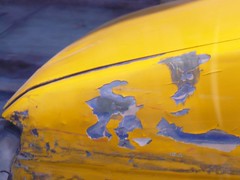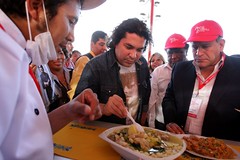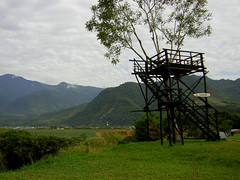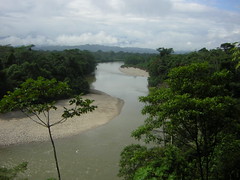1250km of Northern Coast: The usual and the little-known
Written by, and with thanks to, Rafo León
Let’s start in Tumbes, the smallest region in Peru and the one with proportionally the most protected areas: 50% of the territory is covered by mangroves, dry forest and tropical forest. The Usual: From Puerto Pizarro boats can be hired to get to the Isla de Amor where you can enjoy a beer and bathe in the clear sea. The Little-Known: Entering the mangrove sanctuary by taking a boat from Puerto 25, be guided by locals involved in the conservation and protection of this resource, visit the protected area and later dedicate many hours to a refreshing dip in the Zarumilla canal where also, if lucky, you might see a wild crocodile.
Continuing south… The Usual: Stopping off at Zorritos beach, or going straight on to Punta Sal or to Máncora resort towns. The Little-Known: To stay in Caleta Grau at kilometre 1,242, at the edge of Tumbes and Piura. It boasts a large beach lined with simple houses where you can find a good room with bathroom for just 25 soles a night and eat fresh lobster for breakfast, lunch and dinner.
Passing Lambayeque we find more of the Usual: an increasingly modern and posh Pimentel with its long curved pier, pretty houses and sea food. But the Little-Known is just a little more to the south, a place called Santa Rosa, where eating is not only a pleasure but a religious experience. Tortilla de raya, mero en salsa picante, cebiche norteño con zarandaja… and as you eat you can watch the fishermen go out to get another fresh catch.
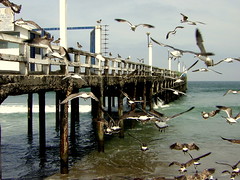
Fishing
Just a little further south is Puerto Eten, a magical place whose splendour was almost unrivalled during the boom in the sugar-industry at the start of the 20th century. This new economic activity lead the then-President of Peru José Pardo y Barreda to declare the small town to be its own district, build a large pier and lay down a railway to make exporting easier and allow the now wealthy producers to import fine European goods. This though, was all in the past. Today Puerto Eten feels somewhat like a ghost town – a shadow of what it once was. Its fine buildings remain, many such as its old train station though now in a state of decay.
At only 667km along the Panamerican highway from Lima, we stumble across Pacasmayo. Its bay is surrounded by some of the richest archaeological zones in the country. In the nearby area, remains of the once great Moche civilisation are worked on rigorously, adding to the information obtained from sites in Trujillo and Lambayeque. This is the Little-Known, as many people visit the region only for the Usual – the beaches and to surf. But for the more adventurous a visit can also involve exploring ruins such as Pakatnamú or San José de Moro.
Pacasmayo conserves its beautiful malecon that begins at the mansion of the Arbaiza-Mendoza family and ends at the grounds of resort Club Pacasmayo. At the resort’s end is a plaza that is home to the best preserved original Republican-era architecture. The city also has its main plaza, well conserved, and its classic little streets where gossip circulates among the old women who make some of the best tamales in Peru.
Beach goers often overlook Pacasmayo and head north, as do many foreign visitors on tours. The town is popular however among surfers, particularly Brazilians, Australians and North Americans. Pacasmayo and Puerto Chicama argue amongst themselves about which of them has has the honour of being home to the longest left-wave in the world.
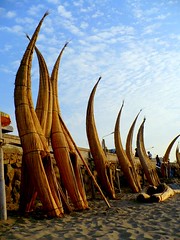
Caballitos de Totora
In Trujillo is the celebrated Huanchaco that continues to be a draw on backpackers and surfers from across the world. The caballitos de totora cut through the waves in competition with surfers, while food-lovers enjoy fresh sea food in the hundreds of restaurants that line the beach. That’s the Usual, but what is the Little-Known? Something very important: at the end of January is expected the inauguration of the Museo El Brujo, where among the riches exhibited are the finds from the tomb of the Señora de Cao. Then there is Las Delicias, here among the mix of traditional and modern architecture, year after year, occurs an event that is surreal: the Sanjosecito – a fiesta that takes place at the end of March and looks just like the Sanfermines de Pamplona event. The women dress in extravagant manola dresses, the older gentlemen in Andalucian boots drink wine, while the young dress in white run while being chased by maddened bulls.
As you can see, in the northern coast of Peru, among the usual attractions and those less known, there is plenty to choose from and more.
Tags: beach, caballitos de totora, caleta grau, chicama valley, huanchaco, isla de amor, jose pardo y barreda, las delicias, mancora, mangroves, moche, museo el brujo, pacasmayo, pakatnamu, pimentel, Puerto Chicama, puerto eten, puerto pizarro, punta sal, san jose de moro, sanjosecito fiesta, santa rosa, señora de cao, tumbes, zarumilla, zorritos




